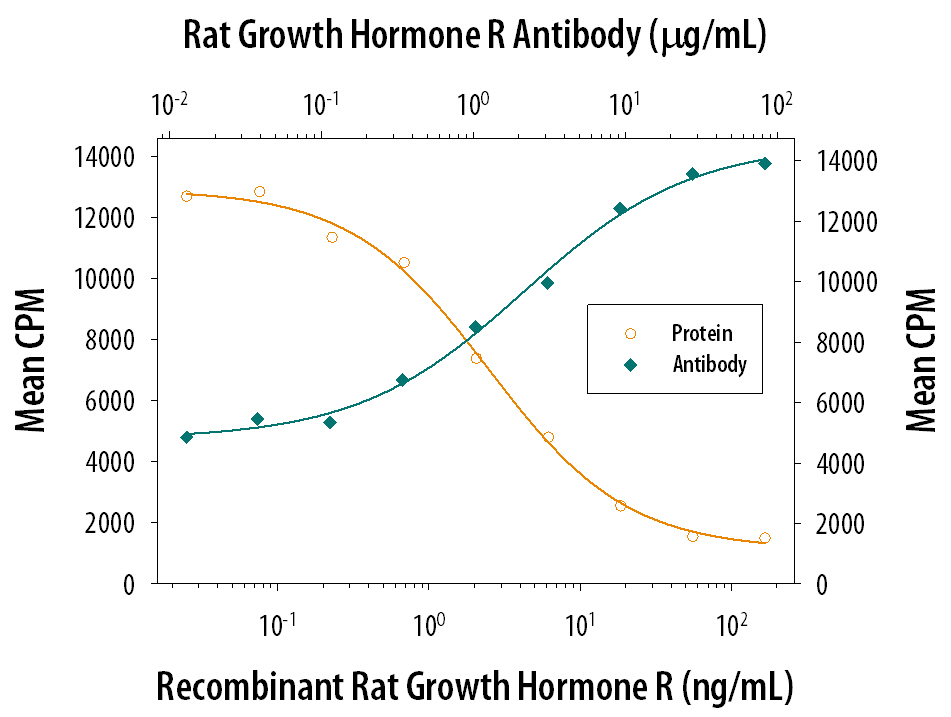Rat Growth Hormone R/GHR Antibody Summary
Phe19-Arg265
Accession # P16310
Applications
under non-reducing conditions only
Please Note: Optimal dilutions should be determined by each laboratory for each application. General Protocols are available in the Technical Information section on our website.
Scientific Data
 View Larger
View Larger
Growth Hormone R/GHR Inhibition of Growth Hormone-dependent Cell Proliferation and Neutralization by Rat Growth Hormone R/GHR Antibody. Recombinant Rat Growth Hormone R/GHR Fc Chimera (Catalog # 1211-GR) inhibits Recom-binant Human Growth Hormone (Catalog # 1067-GH) induced prolifer-ation in the Nb2-11 rat lymphoma cell line in a dose-dependent manner (orange line). Inhibition of Recom-binant Human Growth Hormone (0.2 ng/mL) activity elicited by Recom-binant Rat Growth Hormone R/GHR Fc Chimera (10 ng/mL) is neutralized (green line) by increasing concent-rations of Mouse Anti-Rat Growth Hormone R/GHR Mono-clonal Antibody (Catalog # MAB1211). The ND50 is typically 0.9-3.6 µg/mL.
Reconstitution Calculator
Preparation and Storage
- 12 months from date of receipt, -20 to -70 °C as supplied.
- 1 month, 2 to 8 °C under sterile conditions after reconstitution.
- 6 months, -20 to -70 °C under sterile conditions after reconstitution.
Background: Growth Hormone R/GHR
Growth hormone (GH), also known as somatotropin, is a member of a family of growth factors that includes prolactin, placental lactogens, proliferins and somatolactin (1, 2). It is synthesized primarily by somatotropes in the anterior pituitary and is released as an endocrine hormone. Other cells and tissues, including lymphoid tissues, can also produce GH (3). GH is a pleiotropic molecule which can act directly or indirectly via IGF-I, to regulate growth and metabolism as well as enhance T cell survival and thymic functions (1, 2, 4). GH exerts its biological actions by binding to the GH receptor (GHR) that is present in many cell types (1, 2). Rat GHR cDNA encodes a 638 amino acid (aa) residue type I transmembrane protein with a 18 aa signal peptide, a 247 aa extracellular domain, a 24 aa transmembrane domain and a 349 aa cytoplasmic domain. An alternatively spliced 297 aa isoform of rat GHR also exists. This 279 aa variant corresponds to the serum GH-binding protein and is identical in sequence to the extracellular domain of the transmembrane protein up to Glu262 (5). Ligation of GHR by GH has been shown to result in receptor dimerization and activation of the JAK/STAT signaling cascade (6). The soluble GHBP has been shown to interfere with GH signaling by competing with the transmembrane receptor of GH. Alternatively, the GHBP has also been shown to enhance GH action by slowing GH clearance (5, 7).
- Goffin, V. et al. (1996) Endocrine Rev. 17:385.
- Le Roith, D. et al. (2001) Endocrine Rev. 22:53.
- Clark, R. (1997) Endocr. Rev. 18:157.
- Welniak, L.A. et al. (2002) J. Leukoc. Biol. 71:381.
- Postel-Vinay, M.C. and J. Finidori (1995) Eur. J. Endocrinol. 133:654.
- Carter-Su, C. et al. (1996) Annu. Rev. Physiol. 58:187.
- Frick, G.P. et al. (1998) Endocrinology 139:2824.
Product Datasheets
FAQs
No product specific FAQs exist for this product, however you may
View all Antibody FAQsReviews for Rat Growth Hormone R/GHR Antibody
There are currently no reviews for this product. Be the first to review Rat Growth Hormone R/GHR Antibody and earn rewards!
Have you used Rat Growth Hormone R/GHR Antibody?
Submit a review and receive an Amazon gift card.
$25/€18/£15/$25CAN/¥75 Yuan/¥2500 Yen for a review with an image
$10/€7/£6/$10 CAD/¥70 Yuan/¥1110 Yen for a review without an image

